- 8 Minutes to read
- Print
- DarkLight
- PDF
First Step- Setting up a MyPlan Scenario and Data Trends
- 8 Minutes to read
- Print
- DarkLight
- PDF
Scenarios are used in MyPlan to represent a version of your Budget, Plan or Forecast. They are created based on fiscal year. Generally, most companies have several scenarios that represent different iterations of Budgets and Forecasts. For example, you might create a scenario for current and future trends, with different drivers. For Budgets, you’ll set up a Budget Scenario Type and for a Forecasts, you’ll create a Forecast Scenario Type; both for a different purpose.
Detailed information on all steps to create a Budget or Forecast scenario and all fields on the Scenario Setup page are available in the Scenario Setup Guide. The Scenario Setup information provided in this guide is specific to setup required for MyPlan.
The foundation of MyPlan is built using compare scenarios. MyPlan uses Compare Scenarios to calculate and solve variances. It allows the user to not only quickly correct and adjust variances manually through data input, but it also gives the user the ability to have the system solve the variance for them. Below are the steps for setting up a Scenario for MyPlan.
Data Trends allow users to use prior, present or future data points to help them complete a budget or forecast, by looking at data from any given scenario and time period, in order to analyze and benchmark against their working scenario. Users can use this feature to make actionable decisions by knowing how and what should be Planned, knowing where they are going to ultimately Land, and most importantly have a clear picture of where they currently Stand.
Scenario Setup
Navigate to the Scenario Setup page by selecting Maintenance > Admin > Scenario.
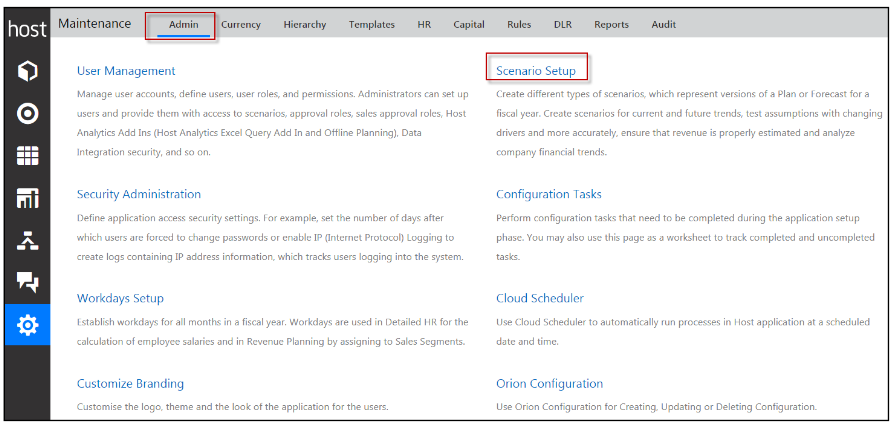
Click the Add button and select a Forecast or Budget scenario type. Once you have completed filling out all fields in the General Information section, click the Data Seeding tab.
In the Data Seeding area, select Enable Data Seeding. Additional fields are displayed.
For Reference Scenario, select the scenario you want to use to populate the scenario you are creating. In this example, a budget scenario is being created, so you would use an Actual or Forecast scenario to pre-populate the data for MyPlan users (2018 Forecast Q4 is used in this example and shown in the screenshot below).
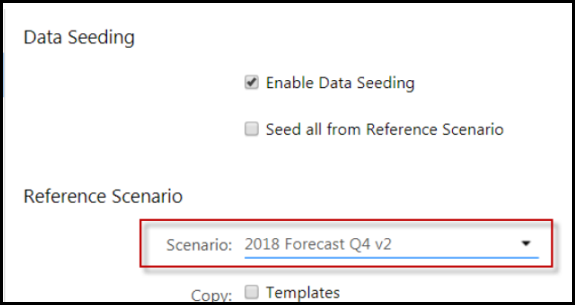
For Seed Data From, select the Varying Scenario and Period Selection. Fill in the Period mappings, select the source scenario (2018 Forecast Q4 v2), and source period as Jan-19. Instead of selecting each period, use the auto increment option to fill in the rest of the periods.
Click Save. The page below displays how the Data Seeding page should look for this example.
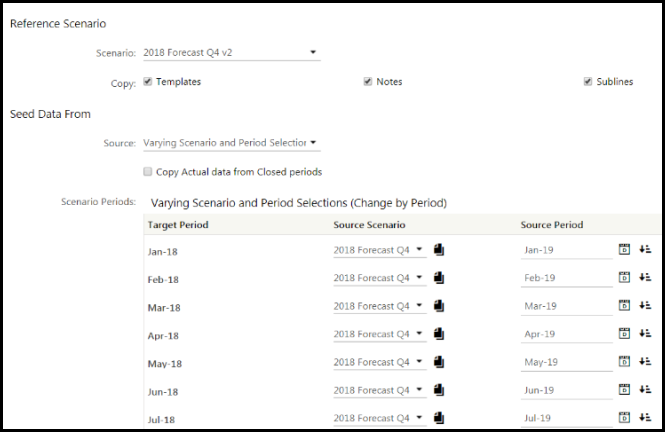
Click the Compare Scenarios tab. Compare scenarios are used to display comparative data from other scenarios such as; historical actuals, latest budget data, data from the prior budget cycles, and plans with budget targets.
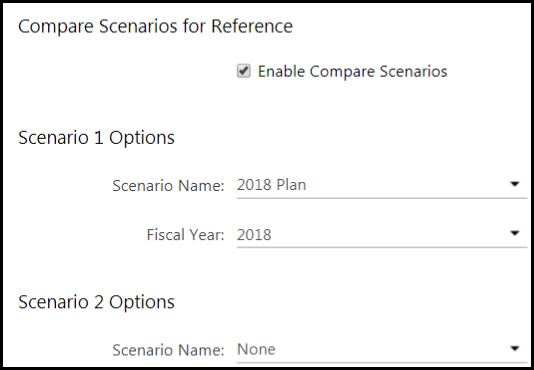
The number of Compare scenarios allowed per scenario is determined during application configuration (Go to Configuration Task List page > Define Budget Parameters task shown below to see how your application was configured).
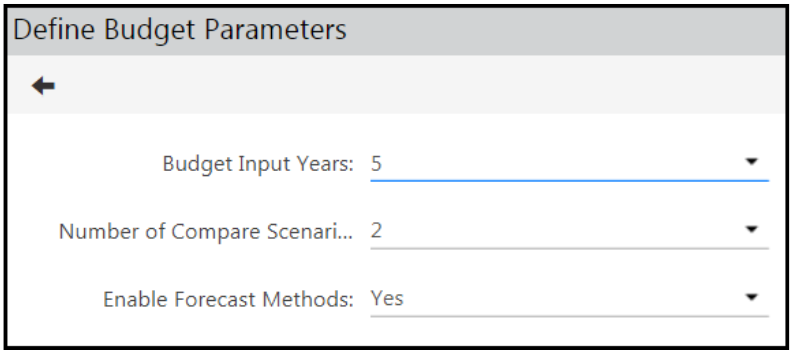
On the Compare Scenario screen, Click the Enable Compare Scenarios checkbox.
For each scenario option, select the compare scenario that you would like the input scenario to compare against. For example, If you are creating a 2018 Forecast scenario, you might compare this input scenario against a 2018 Budget.
.Click the Data Trends Setup tab and select Enable Trend. You will see the budget input years appear.
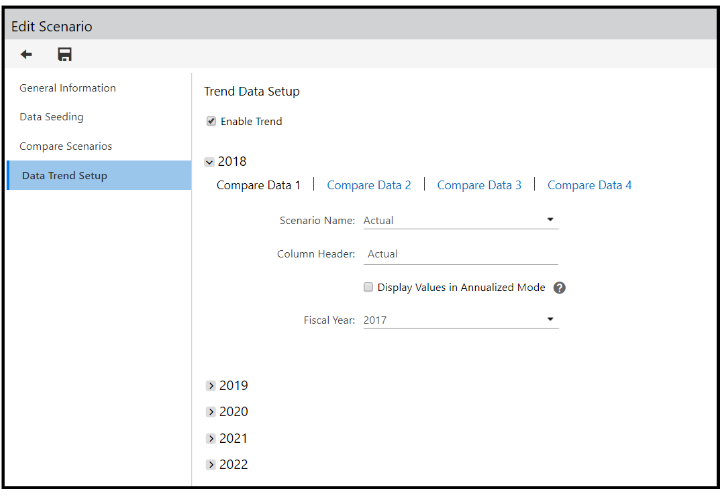
By default the system auto populates the compare data columns with the Actual scenario and the prior year. Use the Scenario Name and Fiscal Year selection (dropdown) to choose what other scenarios you would like to use as a reference for end users to compare against. Use the Column Header option to rename the scenario to something more user friendly (this in only an alias, you are not changing the actual scenario name). Complete for all budget input years based on the reference information you would like to show to end users.
For information on Display Values in Annualize Mode and Adjusting Factor, see Displaying Values in Annualized Mode and Adjusting Factor Explained
If you are creating a forecast, you will have to Navigate to the Scenario Setup page in Planful, by selecting Maintenance > Admin > Scenario. Select the forecast scenario you just created and execute the Refresh Closed Period Data action.
The final step is to create Data Load Rules (DLRs) and load data to the scenarios you just created. Information on loading data is available in the Loading Data to Planful Admin Guide.
Also, It is important that you do not display the same scenario in two or more MyPlan sections. One unique scenario per section is required. Sections are discussed later within this documentation.
Using Different Compare Scenarios Against Multiple Years
For Budget and Forecast scenarios, you can use different compare scenarios against multiple years. This functionality allows you to plan out years and future years using "what if" scenarios and set up a rolling forecast and compare each prior year results with current year results.
For example, let's say you've created a Q2 forecast scenario for years 2018 through 2020 (Q2 Forecast 2018-20). The data from this forecast needs to be compared with data from the Q1 forecast scenario (Q1 Forecast 2018-20). So, each year (2018, 2019, and 2020) for Q2 needs to be compared with the corresponding Q1 forecast scenario for the same years. To accomplish this, setup 3 Compare scenarios mapped to the source scenario and period as shown in the table below.
| Scenario | Compare Scenario |
| Q1 Forecast 2018 | Q2 Forecast 2018 |
| Q1 Forecast 2019 | Q2 Forecast 2019 |
| Q1 Forecast 2020 | Q2 Forecast 2020 |
The last thing you will do is map the Compare scenarios to each of the fiscal years of the forecast scenario.
In Practice
This example shows you how to complete the setup.
Access the Scenario Setup page by navigating to Maintenance > Admin > Scenario Setup.
Click the Add icon to add a new scenario.
Click the Compare Scenarios tab and ensure Enable Compare Scenarios is selected.
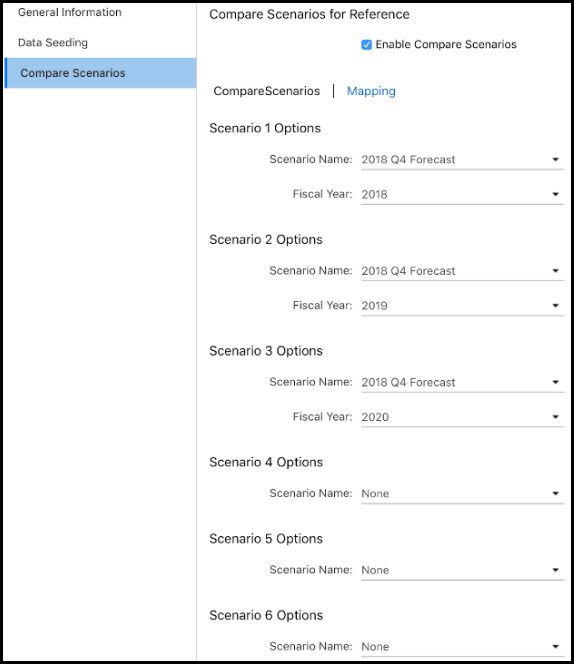
Click the Mapping link.
For each fiscal year in your budget plan or forecast (in this example there are 6 years), map a Compare scenario by selecting it from the list box. Click Save.
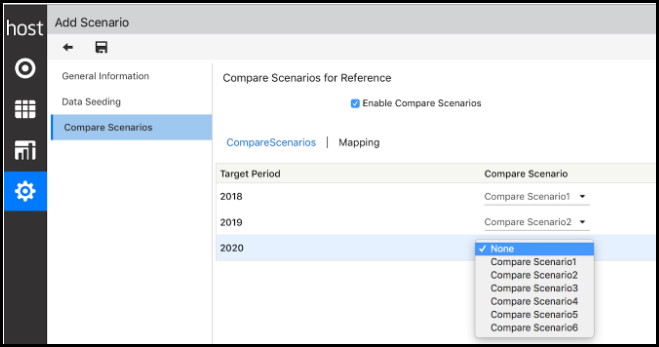
Due Date
MyPlan offers the ability to provide users with a Due Date in which a budget or forecast needs to be completed by. This option is simple to use. Click the Date selection to choose the completion data (see below). This should be done for all scenarios setup and intended for MyPlan usage. This feature cannot be used in the Planning application.

Budget Input Years
Budget Input years determine the number of periods available for input within a template and module. The number of budget input years, defined on the Define Budget Parameters Configuration task screen, also determines the number of quarters and years available in MyPlan selections. In the example below, 5 budget input years were selected when budget parameters were defined, which results in 20 quarters (4 per year) available for selection within MyPlan.
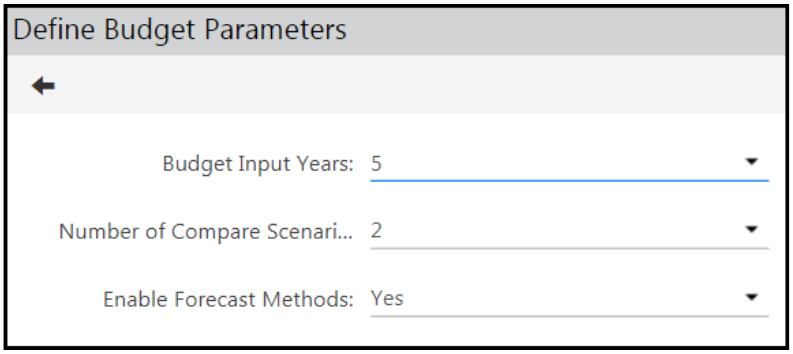
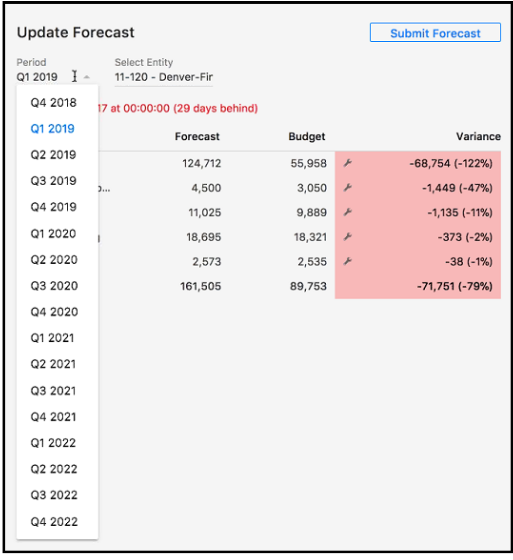
Displaying Data Trends
This section discusses how Data Trends are displayed in the MyPlan interface.
In Practice
Navigate to MyPlan, and select the three vertical dots Icon and then select Show Data Trends. You will see the reference scenario setup that you completed for each Compare Data element displayed. By default, Compare Data 1 will be the first compare scenario shown (see screenshot below).
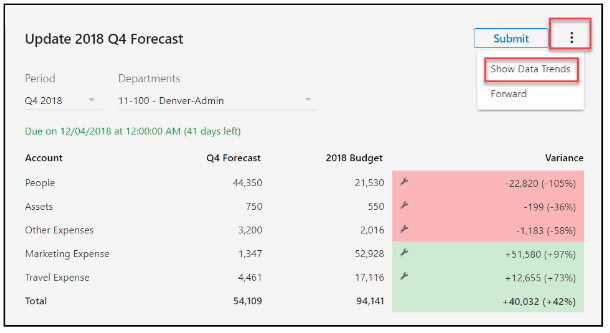
Select the Showing Data dropdown box to access the other Compare Data options.
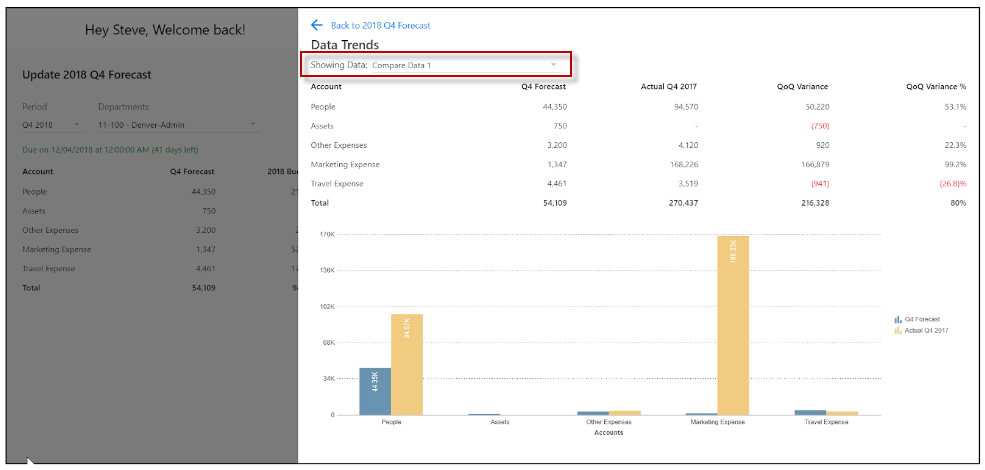
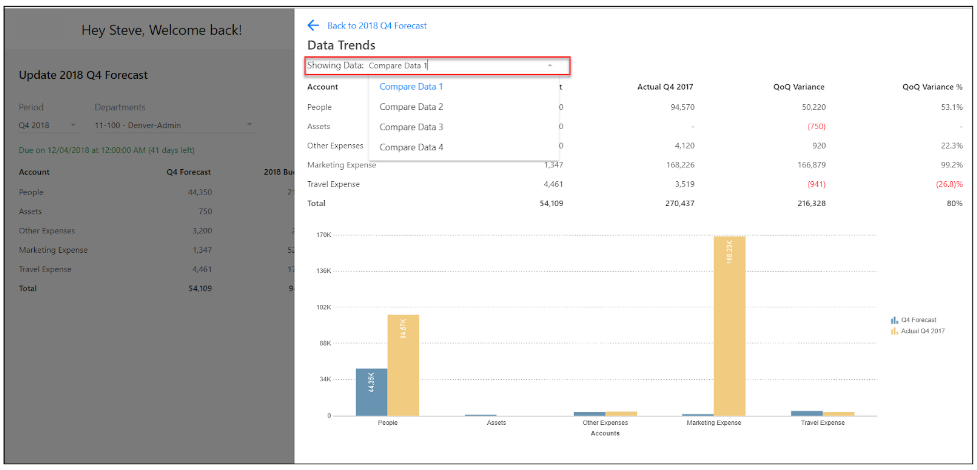
Displaying Values in Annualized Mode and Adjusting Factor Explained
When you set up Data Trends and selected the first section to configure the Compare Data option, there is an option called Display Values in Annualized Mode and the option to add an Adjusting Factor (as shown in the image below). A brief description of these options is provided below.
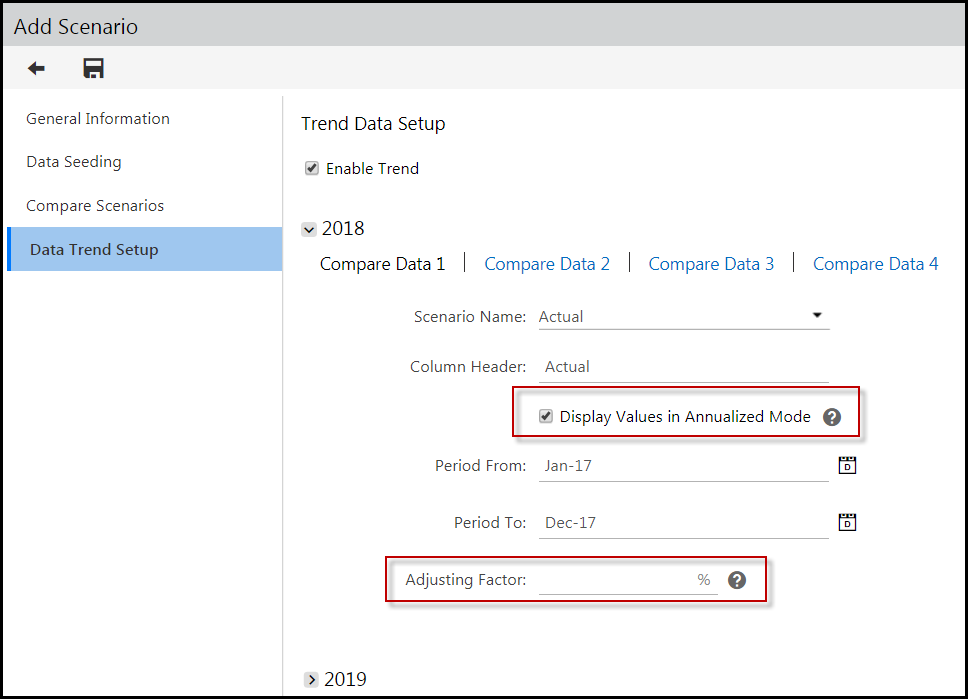
Display Values in Annualized Mode
The Annualized Mode option is used when the Actual scenario, without a full year of data, is used for compare or trend analysis. In such cases, the application will adjust for periods without any data. For example, let’s say a user is generating a Data Trend for the Budget 2019 scenario. The user selects the Actual 2018 scenario for comparative values. However, the application only has Actual data for 9 periods in the Actual 2018 scenario. It is impossible to compare 12 periods of data in the Budget 2019 scenario with 9 periods of data in the Actual 2018 scenario.
If you are in this situation, use the Display Values in Annualize Mode option. When enabled, the application will calculate the average of the 9 periods of Actual data and use the result to populate the remaining 3 periods that were without data.
The calculation to extrapolate the average of 9 periods of data would look like this:
Original Actual 2018 Period Data
| P1 | P2 | P3 | P4 | P5 | P6 | P7 | P8 | P9 | P10 | P11 | P12 |
| 100 | 110 | 120 | 130 | 140 | 150 | 160 | 170 | 180 | No Data | No Data | No Data |
| Total P1 through P9 = 1260 -------1260/9=140 | 140 | 140 | 140 | ||||||||
After Annualizd Mode is Applied
| P1 | P2 | P3 | P4 | P5 | P6 | P7 | P8 | P9 | P10 | P11 | P12 |
| 100 | 110 | 120 | 130 | 140 | 150 | 160 | 170 | 180 | 140 | 140 | 140 |
Adjusting Factor
Adjusting Factor is the average value used and is calculated by the application. For example, If adjustment factor is 10%, then the average value will be calculated and an additional 10% will be added (i.e. $140 + %10 = $154). If you have 3 periods without data, the average (plus 10%) will be used to populate the periods.

